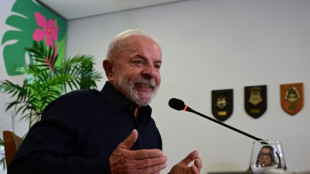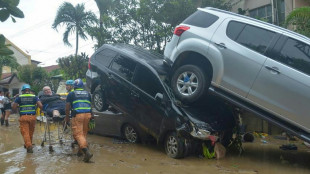
-
 West Indies edge New Zealand despite Santner brilliance
West Indies edge New Zealand despite Santner brilliance
-
French pair released by Iran await return home

-
 German factory orders up but outlook still muted
German factory orders up but outlook still muted
-
Death toll tops 100 as Philippines digs out after typhoon

-
 Attack on key city in Sudan's Kordofan region kills 40: UN
Attack on key city in Sudan's Kordofan region kills 40: UN
-
'No one could stop it': Sudanese describe mass rapes while fleeing El-Fasher

-
 Champagne and cheers across New York as Mamdani soars to victory
Champagne and cheers across New York as Mamdani soars to victory
-
Medieval tower collapse adds to Italy's workplace toll
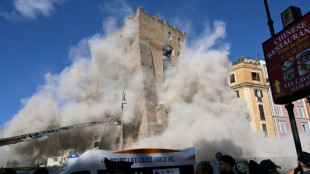
-
 BMW boosts profitability despite China, tariff woes
BMW boosts profitability despite China, tariff woes
-
South Africa's Wiese wary of 'hurt' France before re-match

-
 Asian markets sink as tech bubble fears grow
Asian markets sink as tech bubble fears grow
-
Beyond limits: Croatian freediver's breathtaking record

-
 Tottenham supporting Udogie after alleged gun threat in London
Tottenham supporting Udogie after alleged gun threat in London
-
Thunder roll Clippers to stay unbeaten as SGA keeps streak alive

-
 In appeal, Australian mushroom murderer alleges 'miscarriage of justice'
In appeal, Australian mushroom murderer alleges 'miscarriage of justice'
-
Toyota hikes profit forecasts 'despite US tariffs'

-
 Typhoon death toll soars past 90 in the Philippines
Typhoon death toll soars past 90 in the Philippines
-
Ex-France lock Willemse challenges Meafou to become 'the bully'

-
 Ukrainians to honour sporting dead by building country they 'died for': minister
Ukrainians to honour sporting dead by building country they 'died for': minister
-
At least 7 dead after UPS cargo plane crashes near Louisville airport

-
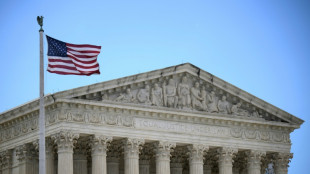 US Supreme Court hears challenge to Trump tariff powers
US Supreme Court hears challenge to Trump tariff powers
-
US government shutdown becomes longest in history

-
 India's Modi readies bellwether poll in poorest state
India's Modi readies bellwether poll in poorest state
-
Green goals versus growth needs: India's climate scorecard

-
 Where things stand on China-US trade after Trump and Xi talk
Where things stand on China-US trade after Trump and Xi talk
-
Sri Lanka targets big fish in anti-corruption push

-
 NY elects leftist mayor on big election night for Democrats
NY elects leftist mayor on big election night for Democrats
-
Injured Jordie Barrett to miss rest of All Blacks tour

-
 Asian markets tumble as tech bubble fears grow
Asian markets tumble as tech bubble fears grow
-
Pay to protect: Brazil pitches new forest fund at COP30

-
 Australia pick 'impressive' Weatherald in first Ashes Test squad
Australia pick 'impressive' Weatherald in first Ashes Test squad
-
Iraq's social media mercenaries dying for Russia

-
 Young leftist Trump foe elected New York mayor
Young leftist Trump foe elected New York mayor
-
Concerns at ILO over expected appointment of close Trump advisor

-
 Venus Williams to return to Auckland Classic at the age of 45
Venus Williams to return to Auckland Classic at the age of 45
-
No deal yet on EU climate targets as COP30 looms

-
 Typhoon death toll climbs to 66 in the Philippines
Typhoon death toll climbs to 66 in the Philippines
-
NATO tests war preparedness on eastern flank facing Russia

-
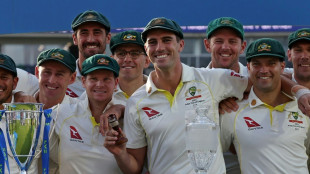 Uncapped opener Weatherald in Australia squad for first Ashes Test
Uncapped opener Weatherald in Australia squad for first Ashes Test
-
CelLBxHealth PLC Presents Proof-of-Concept Study

-
 Evotec SE Reports 9M 2025 Results: Continued Strong Execution on Strategic Priorities
Evotec SE Reports 9M 2025 Results: Continued Strong Execution on Strategic Priorities
-
Coca-Cola Europacific Partners plc Announces Q3 Trading Update & Interim Dividend Declaration

-
 Sassy Gold Announces Cease Trade Order
Sassy Gold Announces Cease Trade Order
-
Gander Gold Announces Cease Trade Order

-
 Ternium to Acquire Nippon Groups' Remainder Participation in Usiminas' Control Group
Ternium to Acquire Nippon Groups' Remainder Participation in Usiminas' Control Group
-
Liverpool down Real Madrid in Champions League, Bayern edge PSG
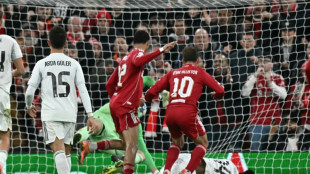
-
 Van Dijk tells Liverpool to keep calm and follow Arsenal's lead
Van Dijk tells Liverpool to keep calm and follow Arsenal's lead
-
PSG left to sweat on injuries to Dembele and Hakimi

-
 Reddit, Kick to be included in Australia's social media ban
Reddit, Kick to be included in Australia's social media ban
-
Ex-Zimbabwe cricket captain Williams treated for 'drug addiction'


Current carbon dioxide levels last seen 14 million years ago
The last time carbon dioxide in the atmosphere consistently matched today's human-driven levels was 14 million years ago, according to a large new study Thursday that paints a grim picture of where Earth's climate is headed.
Published in the journal Science, the paper covers the period from 66 million years ago until the present, analyzing biological and geochemical signatures from the deep past to reconstruct the historic CO2 record with greater precision than ever before.
"It really brings it home to us that what we are doing is very, very unusual in Earth's history," lead author Baerbel Hoenisch of the Columbia Climate School's Lamont-Doherty Earth Observatory told AFP.
Among other things, the new analysis finds the last time the air contained 420 parts per million (ppm) of carbon dioxide was between 14-16 million years ago, when there was no ice in Greenland and the ancestors of humans were just transitioning from forests to grasslands.
That is far further back in time than the 3-5 million years that prior analyses have indicated.
Until the late 1700s, atmospheric carbon dioxide was about 280 ppm, meaning humans have already caused an increase of about 50 percent of the greenhouse gas, which traps heat in the atmosphere and has warmed the planet by 1.2 degrees Celsius compared to before industrialization.
"What's important is that Homo, our species, has only evolved 3 million years ago," said Hoenisch.
"And so our civilization is tuned to sea level as it is today, to having warm tropics and cool poles and temperate regions that have a lot of rainfall."
If global CO2 emissions continue to rise we could reach between 600 - 800 ppm by the year 2100.
Those levels were last seen during the Eocene, 30-40 million years ago, before Antarctica was covered in ice and when the world's flora and fauna looked vastly different -- for example huge insects still roamed the Earth.
- Ancient plants -
The new study is the product of seven years of work by a consortium of 80 researchers across 16 countries and is now considered the updated consensus of the scientific community.
The team didn't collect new data -- rather, they synthesized, re-evaluated and validated published work based on updated science and categorized them according to confidence level, then combined the highest-rated into a new timeline.
Many people are familiar with the concept of drilling into ice sheets or glaciers to extract ice cores whose air bubbles reveal past atmospheric composition -- but these only go back so far, generally hundreds of thousands of years.
To look further into the past, paleoclimatologists use "proxies": by studying the chemical composition of ancient leaves, minerals and plankton, they can indirectly derive atmospheric carbon at a given point in time.
The researchers confirmed that the hottest period over the past 66 million years happened 50 million years ago, when CO2 spiked to as much as 1,600 ppm and temperatures were 12C hotter, before a long decline set in.
By 2.5 million years ago, carbon dioxide was 270-280 ppm, ushering in a series of ice ages.
That remained the level when modern humans arrived 400,000 years ago and persisted until our species began burning fossil fuels at large scales.
The team estimates that a doubling of CO2 is predicted to warm the planet by 5-8 degrees Celsius -- but over a long period, hundreds of thousands of years -- when increased temperatures have rippling effects through Earth systems.
For example, melting the polar ice caps would reduce the planet's ability to reflect solar radiation and become a reinforcing feedback loop.
But the new work remains directly relevant to policy makers, stressed Hoenisch.
The carbon record reveals that 56 million years ago, Earth underwent a similar rapid release of carbon dioxide, which caused massive changes to ecosystems and took some 150,000 years to dissipate.
"We are in this for a very long time, unless we sequester carbon dioxide, take it out of the atmosphere, and we stop our emissions sometime soon," she said.
M.Thompson--AMWN
